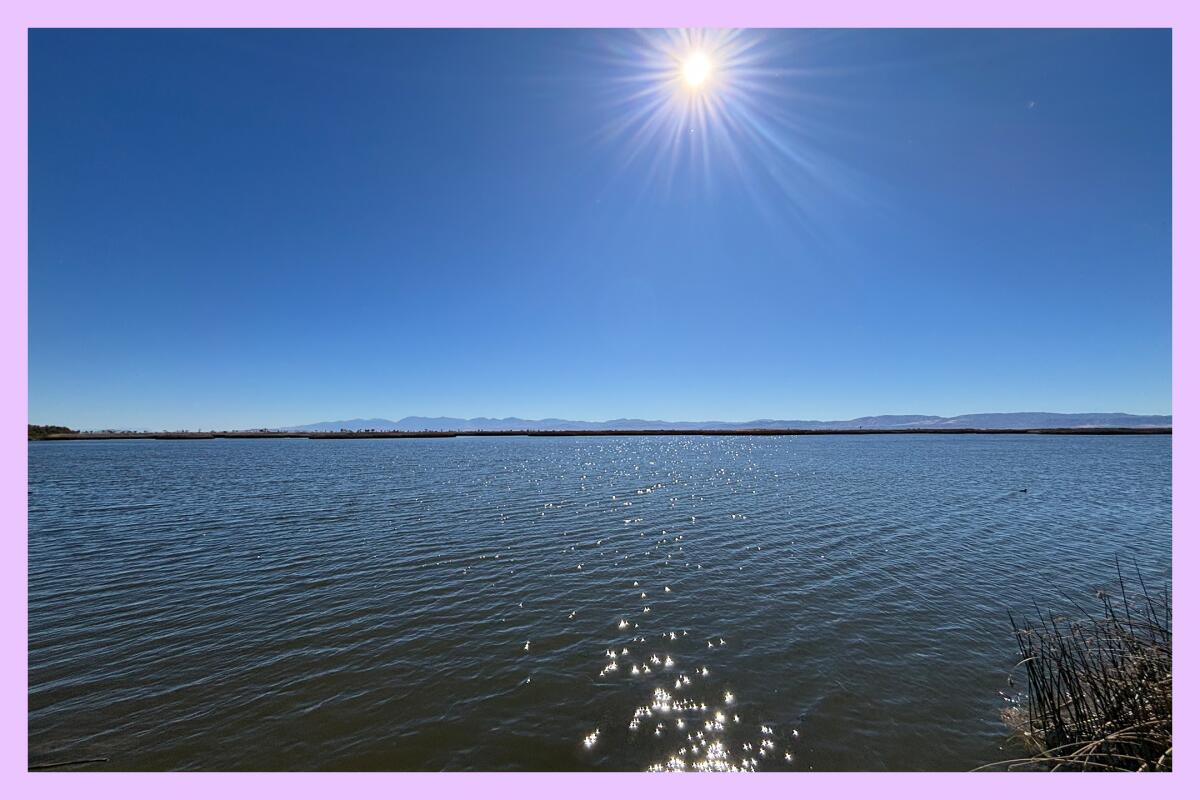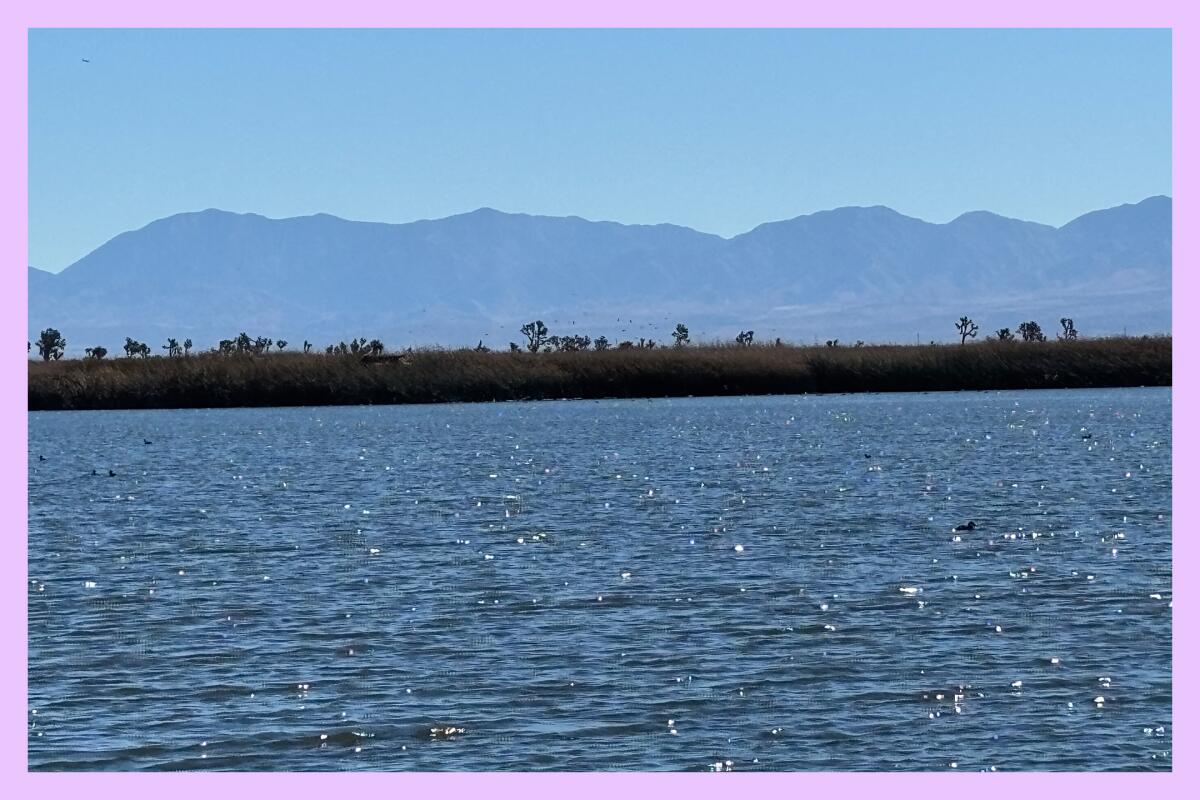Last week, I drove out to Rosamond to visit a paradoxical place: the largest freshwater wetlands in the desert of northern L.A. County. I wondered: Would it really be a modern-day oasis, or just a sad stinky plot of puddles? Dear Wilder, it was the former.
Piute Ponds sits on 9,080 acres in the high desert and features man-made ponds and channels where you can listen to water lapping and ducks quacking among Joshua trees. If you’re wondering why you’ve never heard of it, it’s because it is located on Edwards Air Force Base, and anyone who’d like to visit must first get clearance. But it’s worth the brief bureaucracy (and really bumpy road) to see.
Newsletter
You are reading The Wild newsletter
Sign up to get expert tips on the best of Southern California’s beaches, trails, parks, deserts, forests and mountains in your inbox every Thursday
You may occasionally receive promotional content from the Los Angeles Times.
That’s, in part, because of its location. Piute Ponds is situated along the Pacific Flyway, one of four bird migration routes in North America. It attracts an estimated 300 bird species, including many unexpected migratory ones. Kimball Garrett, the (now retired) ornithology collections manager at the Los Angeles County Museum of Natural History, previously told The Times that he was shocked at the diversity of birds at Piute Ponds. He once counted 13,000 shorebirds among desert birds and many others, all in just one day.

At left, the welcome sign to Piute Ponds on Edwards Air Force Base near Rosamond. At right, native grasses and other vegetation at Piute Ponds.
(Jaclyn Cosgrove / Los Angeles Times)
“There’s no end to the surprises out there,” Garrett said.
As of this writing, birders have observed 108 species just this month, including the snow goose, the small ducks known as cinnamon teal, and even an American kestrel, the smallest falcon in North America, according to its eBird page.
While you’re there, you might even set your binocs on a variety of plants and trees, including black, sandbar and arroyo willows, broad-flowered gilia, the uncommon mojave spineflower and maybe the common sunflower. You might also spot bobcats, coyotes, badgers, kit foxes, muskrats, raccoons and kangaroo rats.
How did such an oasis come to exist in the middle of the desert? I met with Misty Hailstone, a biologist who oversees visitation and management of Piute Ponds, to find out.

Piute Ponds are filled in part with treated wastewater.
(Jaclyn Cosgrove / Los Angeles Times)
As Hailstone and I walked through the grounds, she explained to me how Piute Ponds is a “human modification of a natural system.” The area is surrounded by mountains, making it a closed basin. When water flows from the nearby ranges, it’s funneled to the lowest point in the basin, which is Piute Ponds.
There has always been some water in the region. In the early 1900s, it was common to see it sprouting up in random places because the water table was so high, Hailstone said. But, when farmers arrived and colonized the area for rice farms, alfalfa fields and more, they depleted the resources. And, a growing population in the Antelope Valley also didn’t help.
Piute Ponds is a happy byproduct of a wastewater-related compromise between government officials in the region. Although ephemeral streams bring melted snow and rainwater to its basin, much of its water is from a nearby sanitation plant. Let me explain.
As Lancaster and the surrounding Antelope Valley developed, the population needed a place to release its treated wastewater. In L.A., treated wastewater, if not reused, is discharged to the ocean. But this region is smack dab in the middle of the desert. The county’s sanitation agency started releasing its treated wastewater into the local Amargosa Creek. Water then flowed into dry lake beds near Rosamond. (It’s important to note: This is treated wastewater, not raw sewage)

Joshua trees dot the edge of Piute Ponds — a rare and striking sight.
(Jaclyn Cosgrove / Los Angeles Times)
Then, in the 1930s and ’40s, the U.S. military took over the area, Hailstone said. Military officials couldn’t use lake beds for testing and landing if they had water in them. So, to divert the treated wastewater elsewhere, the sanitation district started building embankments and other containers to keep the wastewater from reaching the lake beds. The amount of treated wastewater grew as more people moved to the desert, and today, Piute Ponds has about 20 ponds, sloughs, marshes, creeks and lagoons.
“All of this is to help contain the water,” Hailstone said. “But then, after a while, we also started looking at how to not just contain the water, but how we [could] create an ecological functioning wetland system that’s not just holding water, but is also good use for native wildlife.”
Within its 9,080 acres, Piute Ponds includes lower Amargosa Creek, ponds, marshes, wetland meadows, low sand dunes, small claypans, interior levees and unpaved roads. Its ponds and water features are within a 2,800-acre region, and the remaining land is mostly upland vegetation.
Looking out over Piute Ponds, I was amazed by how clear the water was. I grew up visiting my mom at a water treatment plant where she worked, but still, I associated “wastewater” with a certain ick factor.
Hailstone explained that, thanks to an upgrade in the sanitation district’s equipment about 12 years ago, the water entering Piute Ponds goes through three levels of treatment. Before it reaches Piute Ponds, it is also dechlorinated, which ensures that the water pumped into Piute Ponds can be a home to beneficial native micro-organisms.

Waterfowl use reeds for shelter at Piute Ponds.
(Jaclyn Cosgrove / Los Angeles Times)
And, where there is water, there is life. Just in my short visit, I saw ducks, falcons, a coyote and some raccoon tracks.
After leaving Piute Ponds, I started texting friends. I already wanted to go back with a better camera and more time to peek through the reeds surrounding its ponds. Or to close my eyes and take in the quiet of the desert. Or catch a glimpse at one of its special Western pond turtles. It might take 90 minutes to reach from downtown L.A., but you can spend hours here and probably see few, if any, people. You can’t say that about many of our wild places in L.A.
To request access to the ponds or ask questions about visiting, email: [email protected]. The base offers everything from a day to seasonal pass, although to get the seasonal pass, you must visit at least once a month.

3 things to do

Cyclists at a recent ActiveSGV event.
(Courtesy of Active San Gabriel Valley)
1. Bike along the river from South Pasadena to Chinatown
ActiveSGV, an equity-focused outdoors advocacy group, will host one of its “Bike the Rivers & Hike the Mountains” events from 8 a.m. to 12:30 p.m. Saturday. The group will meet at the Station Square Park (913 Meridian Ave., South Pasadena) adjacent to the South Pasadena A Line Station. From there, cyclists will take the Arroyo Seco bikeway before connecting to the L.A. River bike path. The ride will conclude at L.A. State Historic Park, near downtown L.A., where the organization will host a raffle. The ride will be about 18 miles with about 450 feet of elevation gain. Riders are required to bring a TAP card, and a functional bike or wheeled device, preferably with gears. Participants should also bring their own filled water bottle. Children and teens under 18 are required to wear helmets. Bikes with training wheels are not permitted, but children are welcome if pulled in a trailer or on-bike child seat. The event page might show that it is sold out, but riders are still welcome, regardless of whether they are able to formally register. Details at eventbrite.com.
2. Clear trails in Altadena
The Mount Wilson Bicycling Association will host a Valley Forge trail work day from 8 a.m. to 2 p.m. Saturday. A volunteer carpool will leave Flanders Road in La Cañada Flintridge at 7:30 a.m. to meet at Eaton Saddle, where parking is limited, at 8 a.m. After a sign-in and safety briefing, the group will hike two miles of the Valley Forge Trail to the work site. The area was burned during the 2020 Bobcat fire. Volunteers will use hand tools like loppers, hedgers and hand saws to clean brush, and also work on restoring the trail’s tread. The group will hike back at noon. The association will provide lunch and refreshments at Eaton Saddle at 12:30 p.m. Participants are required to wear eye protection, gloves, a long-sleeved shirt, long pants and hiking boots. The organization will provide tools and hard hats. Participants should also bring a hydration pack or backpack to carry water and snacks while working on the trail. You will want enough water and snacks to fuel you for six hours in the sun. A camp or beach chair is also recommended for rest during lunch after trail work. Register at eventbrite.com.
3. Restore habitat in the Baldwin Hills
The Nature Nexus Institute will host a habitat restoration event from 9 a.m. to noon Friday at Kenneth Hahn State Recreation Area. Volunteers will learn about native plants and animals as they work to repair habitat. Volunteers ages 12 and up are welcome, although volunteers under 18 must be accompanied by a parent or guardian. Work will be off trail and on uneven terrain. Participants should wear long pants and closed-toe shoes. Bring water and sun protection. Register at naturenexusinstitute.org.

The must-read

This year, President Biden expanded the San Gabriel Mountains National Monument by nearly a third, an action that could be at risk of being undone during the Trump administration.
(Genaro Molina / Los Angeles Times)
After last week’s election, I saw several folks online wondering about how the Trump administration might change environmental policies that protect the lands we love. Seven Times climate reporters worked together on a piece outlining just that. Experts told them that Trump and his Cabinet members might dismantle the National Oceanic and Atmospheric Administration and downsize several environmental or environmental-adjacent agencies, including the Department of the Interior, which both the National Parks Service and Bureau of Land Management are a part of. And, any monuments that Biden has already designated or is going to designate in the coming two months “are at severe risk of being shrunken or eliminated by the Trump administration,” said Brendan Cummings, conservation director for the Center for Biological Diversity. But conservation activists aren’t going down without a fight. “We’ve been here before — and we’re here to double down on our conservation work, which is more imperative than ever,” said Pamela Flick, California program director for Defenders of Wildlife.
Happy adventuring,

P.S.
Also, on Friday night, we’ll have our last supermoon of the year. A supermoon is when the moon’s orbit is closest to the Earth at the same time that we have a full moon. If you want to spot the big lunar cheese, there are tons of great spots to check out in L.A. for a night hike. My hope is to hit the trails and head to Mount Hollywood. I hope to see you there!
For more insider tips on Southern California’s beaches, trails and parks, check out past editions of The Wild. And to view this newsletter in your browser, click here.
